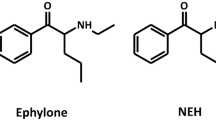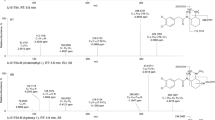Summary
The in vitro and in vivo metabolism of the nonbenzodiazepine anxiolytic agent, RWJ-51204 was investigated after incubation with mice, rat, dog, monkey, and human hepatic S9 fractions in the presence of NADPH-generating system, and a single oral dose administration to rats (100 mg/kg), dogs (5 mg/kg), and humans (2.5 mg/subject). Plasma and red blood cells (2 h, rat) and urine samples (0–24 h, rat, dog and human) were obtained postdose. Unchanged RWJ-51204 (39–93% of the sample in vitro; ≤5% of the sample in vivo) plus 14 metabolites were profiled, quantified and tentatively identified on the basis of API-MS and MS/MS data, and by comparison of synthetic samples.
The in vitro and in vivo metabolic pathways for RWJ-51204 are proposed, and the metabolite formations are via the following five pathways: 1. phenyl oxidation, 2. pyrido-oxidation, 3. N-deethoxymethylation, 4. dehydration, and 5. glucuronidation. Pathway 1 formed 4-hydroxy-2-fluoro-phenyl-RWJ-51204 (Ml, 7–24% in vitro; 5–60% in vivo) in major amounts, OH-benzimidazole-RWJ-51204 (M2, 5–8% in vitro and in vivo) and diOH-phenyl-RWJ-51204 (≤5–16% in vitro and in vivo); in conjunction with pathway 5 produced Ml glucuronide (60% in rat & dog; 17% in human), M2 glucuronide (16% in human). Pathways 2–4 formed minor/trace oxidized, and dehydrated metabolites. RWJ-51204 is extensively metabolized in vitro (except dog) and in vivo in rats, dogs and humans.
Similar content being viewed by others
References
Maryanoff, B.E., Ho, W., McComsey, D.F., Reitz, A.B., Grous, P.P, Nortey, S.O., Shank, R.P., Dubinsky, B., Taylor, Jr., R.J, Gardocki, J.F., (1995): Potential anxiolytic agents, pyrido[l,2-a]benzimidazole: anew structural class of ligands for the benzodiazepine binding site on GABA-A receptors, J. Med. Chem., 38,16–20.
Maryanoff, B.E., McComsey, D.F., Ho, W., Shank, R.P., and Dubinsky, B., (1996): Potential anxiolytic agents — II. Improvement of oral efficacy for the pyrido[l,2-a]benzimidazole (PBI) class of GABA-A receptor modulators, Bioorg. Med. Chem. Lett., 6, 333–338.
Reitz, A.B., Jordan, A.D., Sanfilippo, P.J., and Vavouyios-Smith, A., ( 1998): US Patent, 5,817,668,6.
Maryanoff, B.E., Nortey, S.O., McNally, J.J., Sanfilippo, P.J., McComsey, D.F., Dubinsky, B., Shank, R.P., and Reitz, A.B., (1999): Potential anxiolytic agents. 3. Novel A-ring modified pyrido[ 1,2-a]benzimidazole, Bioorg. Med. Chem. Lett., 9 1547–1552.
Scott, M.K., Demeter, D.A., Nortey, S.O., Dubinsky, B., Shank, R.P., and Reitz, A.B., (1999): 4 New directions in anxiolytic drug research, Prog. Med. Chem., 36,169–200.
Jordan, A.D., Vaidya, A.H., Rosenthal, D.I., Dubinsky, B., Kordik, C.P., Sanfilippo, P.J., Wu, W.N., and Reitz, A.B., (2002): Potential anxiolytic agents, part 4: novel orally-active N5-substituted pyrido[l,2-a]benzimidazoles with high GABA-A receptor affinity, Bioorg. Med. Chem. Lett.,12,2381–2386.
Dubinsky, B., Vaidya, A.H., Rosenthal, D.I., Hochman, C., Crooke, J.J., Deluca, S., Devine, A., Cheo-Isaacs, C.T., Carter, A.R., Jordan, A.D., Reitz, A.B. and Shank, R.P., (2002): 5-Ethoxymethyl-7-fluoro-3-oxo-l,2,3,5-tetrahydrobenzo[4,5]imidazo [l,2a]pyridine-4-N-(2-fluorophenyl)carboxamide (RWJ-51204), a new nonbenzodiazepine anxiolytic, J. Pharmacol. Exp. Ther., 303,777–790.
Wu, W.N., McKown, L.A., Reitz, A.B., andTakacs, A.R., (1998): In vitro metabolism of the anxiolytic agent, RWJ-51204, in mouse, rat, dog, monkey and human hepatic S9. The AAPS Annual Meeting and Exposition, Abstract no. 1167, Pharm. Sei., 1, PS36.
Wu, W.N., and McKown, L.A., (1999): In vivo metabolism of anxiolytic agent, RWJ-51204, in the rat and dog, The 9th N. Amer. ISSX/ACS-DCT Meeting, Abstract no. 34, ISSX Proceedings, 15,174.
Wu, W.N., McKown, L.A., and Reitz, A.B., (2002): Metabolism of the anxiolytic agent, RWJ-51204, in human (2.5 mg/subject single oral dose), catalyzed by CYP3A4 isoform, The 11th N. Amer. ISSX Meeting, Abstract no. 163, Drug Metab. Rev., 34,82.
Author information
Authors and Affiliations
Rights and permissions
About this article
Cite this article
Wu, W.N., McKown, L.A. & Reitz, A.B. Metabolism of the new nonbenzodiazepine anxiolytic agent, RWJ-51204, in mouse, rat, dog, monkey and human hepatic S9 fractions, and in rats, dogs and humans. European Journal of Drug Metabolism and Pharmacokinetics 29, 263–268 (2004). https://doi.org/10.1007/BF03190609
Received:
Issue Date:
DOI: https://doi.org/10.1007/BF03190609




